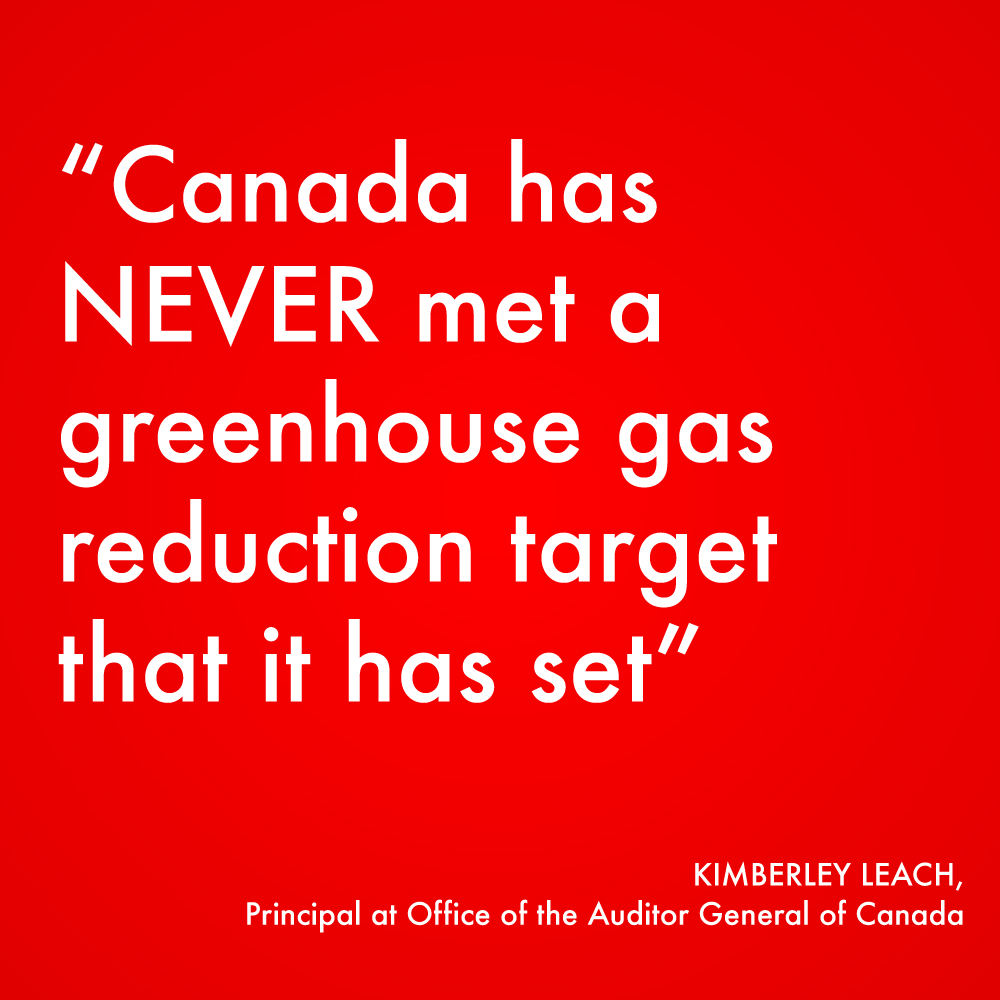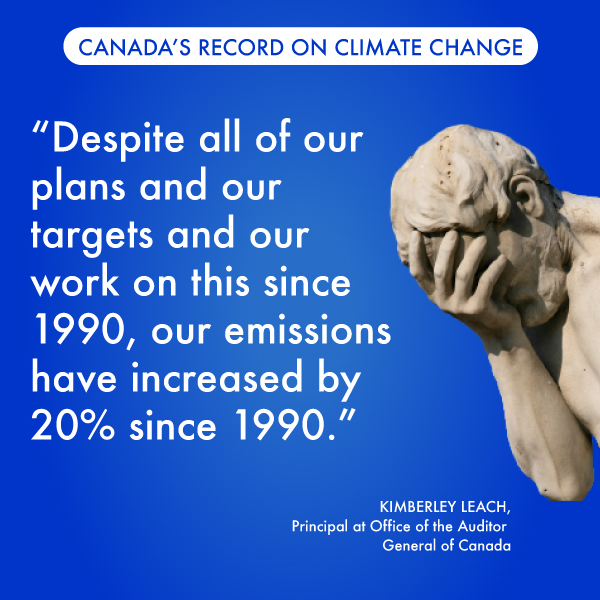Why an Emissions Cap?

OK, we know this isn’t the sexiest topic, but it’s an important one, and it affects all of us.
Currently, the federal government is drafting regulations for a cap on oil and gas sector emissions. The oil and gas industry is the largest emitter of greenhouse gases in Canada—and the industry’s lobbyists are doing everything they can to keep it that way
Do we really need a cap?
Canada has set national goals and targets for reducing greenhouse gas emissions, including for the oil and gas sector. But these targets aren’t working.


See Lessons Learned from Canada’s Record on Climate Change, 2021, Office of the Auditor General of Canada
The fact is, without stronger regulations, including accountability and tougher penalties, the oil and gas industry simply isn’t going to forego its massive profits—even for the health and well-being of humanity. In fact, oil and gas sector emissions have risen more than emissions in any other sector of the economy: 88% since 1990.
A cap—particularly a “hard” cap—on emissions would send a loud message to oil and gas companies that its business-as-usual days are numbered.
A strong emissions cap would also signal to the provinces that they have to get serious about transitioning to clean, renewable energies.
Yes, but… It’s normal to have doubts and concerns when it comes to changing how we do things. So let’s address some of them.
Yes, what about jobs? Did you know that the fossil fuel sector (oil, gas, and coal) accounts for less than 1 percent of all jobs in Canada? The fossil fuel industry has done an impressive job inflating its role as an employer. It’s also snuffed out a lot of union jobs. Canada’s mining sector, which includes oil and gas, “has experienced the most rapid decline in union representation of any sector in the Canadian economy.”
Once again, Big Oil has outdone itself convincing Canadians that the rising cost of oil and gas is simply a function of the market. But the truth is, the biggest chunk of those inflated prices is going directly into corporate profits. Last year, the oil and gas industry saw its biggest profits ever recorded, while consumers struggled to keep up with rising costs.
An emissions cap won’t shut down the oil and gas industry, but it will force companies to clean up their act (and their methane leaks). Hopefully, a cap will also discourage new investments in oil and gas exploration or pipelines. This may increase prices at the pump, but it will also accelerate a transition to electric vehicles (and bring their prices down), encourage investments in public transportation, and support more local services as well as pedestrian- and bike-friendly municipal planning. All of this would amount to paying less for transportation than we do today.
Heating and cooling our homes with oil and gas simply isn’t sustainable. Governments know it and are rolling out financing to help low-income households transition to energy-efficient heat pumps, which can also provide cooling during the increasingly hot summers. In Nova Scotia, the government recently committed to providing free electric heat pumps to low-income families, along with any electrical panel upgrades needed to install them. New Brunswick, PEI, and NL also have programs to help households get off oil and gas and improve energy efficiency.
A hard cap on emissions will signal to provincial governments (and the federal government) that they need to increase funding and support for these programs, and also expand the criteria to include more middle-income households and ensure renters benefit, too.
Yes. We can start by cutting off government subsidies to the oil and gas industry and use that money to fund the transition to clean, renewable energy and support healthy, sustainable communities.
Depending on how one defines a “subsidy,” the oil and gas sector in Canada received an estimated $4.5 billion to $18 billion to $81 billion in government subsidies in 2020. Whether you choose the low-ball amount or the higher-end estimates, that’s a lot of taxpayer dollars—your tax dollars.
And frankly, we can’t afford not to do this. Hurricane Fiona caused nearly $4 billion in damages, much of it in Atlantic Canada.
If you’re wondering whether a federal emissions cap is really relevant to you or your province, the answer is yes—no matter what part of the country you live in. Here’s why.
That’s right. A strong emissions cap will shift Canada’s economy toward job creation in the renewable energy sector and free up more tax dollars that are currently propping up the fossil fuel sector. These new jobs will outstrip job losses in the oil and gas industry. Many fossil fuel workers are already making the transition to renewable energy jobs.
Wind energy is the least expensive source of energy we have today. A cap on oil and gas sector emissions will spur the electrification of our homes, businesses, and entire economy. With renewable energies such as wind, solar, and existing hydro providing electricity, we can transition away from expensive oil, gas, and coal, and lower our energy bills.
The shift to renewable energy will strengthen provinces’ energy security rather than weaken it. The war in Ukraine and volatile international oil and gas prices and supply have driven home the need to support local renewable energy. Not only will it buffer us against geopolitical tensions and OPEC decisions, but it will also enable provinces to decentralize and diversify their energy systems, which is key to making communities more resilient to extreme weather events caused by climate change.
A hard cap on emissions will help provinces understand which alternatives to oil and gas they have time to pursue. The cap would set a 2030 deadline to rein in greenhouse gas emissions (unless the oil and gas lobby succeeds in pushing it into the next decade). That means any new proposals for megadams, small modular nuclear reactors, fracking, LNG plants, or offshore oil and gas exploration and drilling would have to be evaluated in light of meeting a 2030 emissions cap.
So what do you say? Will you join us in telling your local MP—and Prime Minister Justin Trudeau—to deliver a hard cap on emissions?
Learn more about the emissions cap at cappollution.ca
